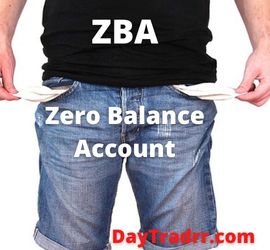ZBA – What Is a Zero Balance Account?
 A ZBA (zero balance account) is a specialized business account. It is used to process payments like payroll or petty cash. Otherwise, a ZBA is kept with a zero balance. In other words, a zero balance account (ZBA) is precisely what it sounds like. It is a business checking account with a balance of zero. However, when funds are necessary, the precise amount required is transmitted automatically from a central or master account. Deposits are also swept into the main account on a daily basis. Corporations may employ zero balance accounts to guarantee that money is easily available across departments. However, it removes surplus balances in separate accounts and keeps greater control over cash disbursement. For example, payroll, petty cash, and other related needs are handled via these accounts.
A ZBA (zero balance account) is a specialized business account. It is used to process payments like payroll or petty cash. Otherwise, a ZBA is kept with a zero balance. In other words, a zero balance account (ZBA) is precisely what it sounds like. It is a business checking account with a balance of zero. However, when funds are necessary, the precise amount required is transmitted automatically from a central or master account. Deposits are also swept into the main account on a daily basis. Corporations may employ zero balance accounts to guarantee that money is easily available across departments. However, it removes surplus balances in separate accounts and keeps greater control over cash disbursement. For example, payroll, petty cash, and other related needs are handled via these accounts.
The account’s surplus balance is transferred to a master account on a daily basis. Also, numerous zero balance accounts (or sub-accounts) may flow into the same master account. If the ZBA needs money, the exact amount can be transmitted automatically and then wired to the proper recipient. In this way, it keeps the account’s running balance at zero. As a result, these types of accounts are only used to process payments. They are not designed to be savings accounts or to earn interest.
How a ZBA – Zero Balance Account Works
A ZBA requires a master account to control the bulk of a firm’s funds. The master account serves as a centralized location for managing an organization’s money. When funds are needed, the funds are transferred from the master account in the precise amount needed. Funds arrive on a prearranged basis in the ZBA checking account to pay a charge or transaction. Because the procedure is totally automated, there is no need for staff to conduct this manually. Concentrating cash in the master account makes more money accessible for investments. This is as opposed to having tiny dollar amounts idle in a number of subaccounts.
The master account frequently provides extra perks, such as a greater interest rate on balances. However, the master account is not a checking account. Rather, it is another category of bank account that is more profitable. As a result, ZBAs maximize accessible money for investment while minimizing the danger of overdraft penalties on numerous sundry accounts.
ZBA slave account
The ZBA’s activity is confined to payment processing and is not utilized to keep a running balance. For example, using a ZBA to finance the organization’s debit cards helps guarantee that every card activity is pre-approved. Because idle money is not available in the ZBA, no debit card transactions may be processed until funds are added to the account. This can aid in the management of corporate costs by reducing the possibility of unauthorized activities taking place. When controlling incidental expenditures across a big firm, the adoption of a ZBA as a spending control tool is extremely beneficial. While operating expenditures are frequently easier to foresee and budget for, incidentals can be unpredictable. Further, by restricting instant access to cash via debit cards, necessary approval processes are more likely to be followed prior to the fulfillment of a purchase. This allows for easier tracking of transfers and account reconciliation.
ZBA – Example of a Zero Balance Account
The master account of a company has $4,000 in cash. Its three zero balance accounts are at zero at the start of the business day. As the day passes, each sub-account receives repeated payments and cheques, resulting in each account containing $80, $120, and $200, respectively. The zero bank account bank sweeps all of this from the sub-accounts into the master account at the end of the day. The master account now has a balance of $4,400 at the start of the next day, while the sub-accounts are back to zero. Every business day follows the same protocols.
What happens when a ZBA goes negative? At the end of the business day, the bank sweeps the debt to the master account. Rather than keep the debt in the zero balance account for the next day, it’s moved to the master account so the ZBA can return to $0. So, for example, the next morning, the above-referenced master account has a starting balance of$4,400. However, the three sub-accounts end the day with balances of $40, $20, and $-100. The balances are swept into the master account at the end of the day. Therefore, the master account then has a balance of $4,360 at the start of the next day: $4,400 + $20 + $40 + ($-100) = $4400 – $40 = $4,360.
Benefits of a ZBA
So, why are companies doing this? It is because ZBA accounts provide better control over departmental finances for a bank’s larger clients. Instead of having different accounts for each department where cash may be allocated, say, per quarter, a zero balance account allows funds to be moved precisely when needed. This prevents any surplus from remaining in the account and resulting in unproductive expenditure. A zero balance account has various further advantages:
Zero Balance Account Benefits
- More efficient – Automation is used to manage zero balance accounts. That means employees don’t have to manually clear the account at the end of each day. Further, they don’t have to worry about time zones if their offices are in separate regions. The bank has processes in place to guarantee that the account is swept to zero at EOB, regardless of where the office is located. If a cheque is drawn on the account, the ZBA also transfers the exact amount required to clear the cheque, eliminating the need for staff intervention.
- Higher yield – The master account usually earns a higher interest rate than the sub-account. Zero balance accounts are not intended to be used as checking accounts. Therefore, it pays to keep cash in an interest-bearing, consolidated master account.
- Greater control – Departments will need to submit a request for funding if they want cash from a zero balance account. You may ensure that protocols are always followed by insisting on official requests for funding every time. This further assists in avoiding project overspending.
- Prevents fraud – Businesses must authorize any withdrawals from the master account into their sub-accounts. This implies that unlawful expenditure is all but eliminated. If a corporate card is used to pay for a cost that has not been approved, the payment will be rejected. This is another layer of fraud prevention.
Can anyone have a ZBA?
No, banks that offer zero-balance accounts will not provide this product to common customers. A ZBA is primarily a commercial banking option. Furthermore, smaller firms may not qualify or be able to obtain ZBAs from institutions that provide them. Banks typically make these accounts available to only their largest customers.
For example, to enhance budget management and make the process of allocating cash more effective, an organization may have many zero balance accounts. Creating a distinct ZBA for each department or function as a tool to track daily, monthly, or annual expenses is another example. Other reasons for establishing distinct ZBAs might include the financial management of certain short-term projects. Or, those projects that are particularly vulnerable to unanticipated overages. The usage of zero balance accounts aids in the prevention of excessive charges that occur without sufficient notice and authorization.
Up Next: What Is an Acquirer in Mergers and Acquisitions?
 In a merger or acquisition, an acquirer is a firm that gains the rights to another company or commercial connection through a financial transaction. These can be mergers, acquisitions, or other types of structured agreements. Acquirers buy out a firm and take over ownership by purchasing a substantial block of the target company’s stock. There are several reasons why a corporation would be interested in purchasing another company.
In a merger or acquisition, an acquirer is a firm that gains the rights to another company or commercial connection through a financial transaction. These can be mergers, acquisitions, or other types of structured agreements. Acquirers buy out a firm and take over ownership by purchasing a substantial block of the target company’s stock. There are several reasons why a corporation would be interested in purchasing another company.
These factors may include reducing competition, developing new competencies or synergies, and accessing new markets. The type and structure of the deal influences acquirer relationships. Corporations can acquire another company through a number of different methods. For example, negotiations and payment of an agreed-upon fee for the right to assume control of another firm and incorporate it into their present business operations. Acquisitions can take the shape of a cash buy-out, a stock purchase, a stock exchange, or a combination of ant of the above.




